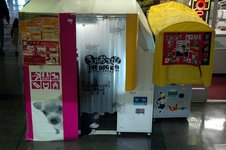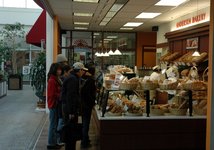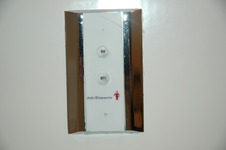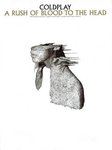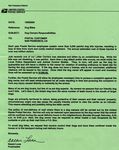 |
| Angelika/Mike Schilli |
|
Angelika Everybody knows San Francisco's Chinatown. Even those who have never visited San Francisco are familiar with this Asian district through many films. Who could forget the chase scene in the classic "What's Up Doc?" through the Chinese New Year parade? Even though today's "Chinatown" has probably too many cheap and kitschy souvenir shops, it still remains a must-see for every tourist, and we too enjoy strolling through the narrow, colorful streets.
Very few tourists, on the other hand, wander into Japantown. Recently, however, some travel guides must have featured the district, which we've noticed because there are now tourists -- armed with the aforementioned travel guides -- sitting in our favorite Japanese restaurants and bravely consuming Japanese food.
The charm of Japantown is only revealed to the visitor on second glance. At first glance, it is no more than a large shopping mall -- squeezed between the Miyako Hotel and the Kabuki cinema, surrounded by the Geary, Post, Fillmore and Laguna Streets.
In Figure 1 you can see that the street signs in Japantown are bilingual: On top it says "POST", which is typical in America, because the word for street ("Street") is never on the sign, unlike in Germany. It's clear that it's a street. Americans don't like unnecessary redundancy. The small sign with "1600" and the arrow to the right indicates that the house numbers start from 1600 to the right of the sign. To the left of it, they are lower.
Below it is the Japanese sign. On it are four Japanese characters. The left three are "Katakana" characters, which are used to phonetically sound out foreign words in Japanese. The first three characters are pronounced "Po-Su-To". Since Japanese people don't know hard consonants without vowels, "Post" is not easy to pronounce. That's why vowels are simply added to the "S" and "T" in "Post", because "Su" and "To" are common Japanese syllables.
Just to let you know: The three Katakana characters do not mean "Post" in Japanese. They only phonetically sound out the English word, which sounds a bit strange, but that's how Japanese people speak English. By the way, when Japanese people pronounce "Yahoo!", it almost sounds like "Yafoo!", although not quite, as the sound is somewhere in between "hoo" and "foo". On with the Japanese street sign, though: The fourth character is in Kanjii, yet another character set, it's pronounced "machi" and it symbolizes "Street". By the way, should you ever get invited to a party or quiz show, you can boast that you know that all Japanese Kanjii characters are identical to Chinese characters, but are pronounced very differently than in China.
Japantown's architecture is actually quite ugly, since the two shopping malls, named "Kintetsu" and "Miyako", were built in a bit of a modernization frenzy in the late 60s, to which many Victorian houses fell victim. Lots of concrete, little design. This also weighs on the so-called "Peace Plaza", which lies between the two malls, with its pagoda (also made of concrete) and a modern fountain. But if you want to discover a piece of Japan in San Francisco, or, like us, have a weekly longing for the land of the rising sun, head to "Nihonmachi". That is the Japanese word for Japantown: With "Nihon" (or Nippon), the Japanese are known to refer to their own country Japan.
Before the Second World War, San Francisco's Japantown was much bigger. The internment of Japanese living in America during the Second World War abruptly ended this. Since Japan had allied with Germany at the time and attacked the West in Pearl Harbor, President Roosevelt issued Order 9066 in 1942. All citizens of Japan living on American soil (even those with American citizenship) were forced to live in internment camps such as "Manzanar" (Rundbrief 12/2001). After their release, most Japanese did not get their homes back and, as a result, did not return to their familiar neighborhoods.
Despite all this, one can still find stores in Japantown today that have been in family ownership for generations. "Soko Hardware" is one of them. Here you can find not only typical DIY items such as cables, tools and paint buckets, but also original Japanese goods such as rice cookers, sushi knives, tatami mats and Japanese crockery. For months, they had a high-tech toilet on display in the window, which we already knew from our trip to Japan (Rundbrief 06/2002). Michael was overwhelmed and wanted to buy it. I could only barely stop him.
The stationery store "Kinokuniya" is again one of my favorite stores. I have always had a passion for good writing pens and the store carries hundreds of them. Already in my tender school age there was nothing better for me than the brand new Geha felt-tip pen package. I admit it openly: the Japanese know how to make good pens. And so I stand dreamily in front of the pen shelves and try one after the other, while Michael shifts from one foot to the other. The eponymous, associated book store, representing a well-known Japanese bookstore chain, is directly opposite the pen paradise. It not only carries a huge selection of literature, magazines and comics ("mangas") in Japanese language but also books on all possible Japanese and Asian topics in English.
"Ichiban-Kan", the Japanese version of a "dollar store", is also very popular with us. Here, you can buy all kinds of knick-knacks, from chopsticks to Japanese sweets and snacks to cosmetics. Recently we discovered our favorite drink Gokuri (Rundbrief 06/2002) there at a bargain price. The drink is also hard to get in San Francisco's Japantown. As is always the case in such stores, the grapefruit drink was quickly sold out.
Our main activity on our visits to Japantown is of course to indulge our culinary palates. If we are in the mood for a Japanese soup with Udon (thick white noodles) or Soba (thin buckwheat noodles), we frequent "Mifune".
If the line at "Mifune" is too long again, we'll stroll over to "Sapporo-Ya" whose specialty is ramen noodles (more Chinese-style). When we have guests who are new to sushi, we take them to "Isobune", where the sushi is placed on small boats swimming around in a circle right in front of you - so you can wait until something you might like is floating by just take the plate off the boat that you dare to eat. The sushi chefs are in the middle and prepare raw fish specialties on rice at lightning speed and with great dexterity. Many insiders in San Francisco say that the quality of the sushi at "Isobune" is rather average. But it's still fun.
Now comes the absolute secret tip, which you hopefully keep to yourself: "Takara", where you can get excellent Japanese home cooking. In our humble opinion, "Takara" offers the most authentic food - including the service: Michael and I usually always order a special lunch, where you can choose three bites of Japanese delicacies from an extensive list. But when Michael once ordered a mackerel, a salmon and a schnitzel, the waiter rolled his eyes in indignation and almost refused to accept the desired order. Twice grilled fish; that was too much for his Japanese soul.
After lunch, if you still have a craving for something sweet or bread in German style, take a stroll to Andersen Bakery (Rundbrief 12/2003). This branch of the bakery from Hiroshima, founded by a Dane, does not offer Japanese delicacies, but European style bakery goods. When looking at the baked goods, we always think we are in a German bakery (just without the rolls). Andersen's cheesecake also is unbeatably good.



